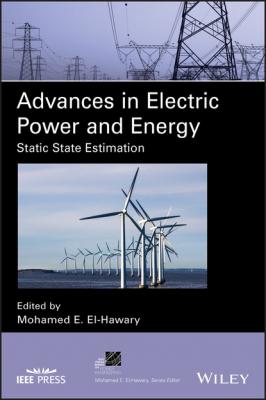Advances in Electric Power and Energy. Группа авторов
Читать онлайн.| Название | Advances in Electric Power and Energy |
|---|---|
| Автор произведения | Группа авторов |
| Жанр | Физика |
| Серия | |
| Издательство | Физика |
| Год выпуска | 0 |
| isbn | 9781119480440 |
2.3.1 Bad Measurement Detection
If measurements are Gaussian distributed and independent, and if the weighting factors wi correspond with the inverse of the measurement variances (
where 1 − α is the confidence level.
Therefore, for a given α (e.g. 0.01), the value χ2(1 − α, m + r − n) can be computed and the χ2 test applied, i.e. if
Example 2.3 Bad Measurement Detection Example
The voltage measurement at bus 1 (Figure 2.1) is considered to be 1.05 instead of 1.0933, i.e. a bad measurement is introduced. Solving the estimation problem, the optimal objective function value is
The test threshold at 0.99 confidence level (α = 0.01) with 10 + 2 − 7 = 5 degrees of freedom is χ2(0.99,5) = 15.0863. Therefore, since χ2(0.99,5) < 16.6008, we conclude that bad data plague the measurement set with a 0.99 confidence level.
For the initial case and since
2.3.2 Identification of Erroneous Measurements
If the bad measurement test detects bad measurements, these measurements should be identified. This is accomplished below.
Consider the nonlinear measurement model
where xtrue is the unknown true state vector and e is the measurement error vector. Note that
(2.15)
which is a typical assumption in state estimation.
Consider the differential measurement equation:
(2.16)
If measurements are Gaussian distributed and independent, the least squares estimator
(2.17)
This minimization problem leads to the system of equations:
(2.18)
known as the system of normal equations [8]. Assuming that the gain matrix
has an inverse, the least squares estimates
(2.20)
from which we conclude that
The residual and the differential residual are defined as
(2.22)
Thus
where P = HG−1HTW is known as hat or projection matrix.
Integrating (2.23), the linear transformation from z to r at the optimum is
where k is a constant vector and S is known as the residual sensitivity matrix.
If measurements z are Gaussian distributed and independent with zero mean and covariance matrix R (R = W−1) and
(2.26)
The normalized residual (N(0, 12)) of measurement i is
